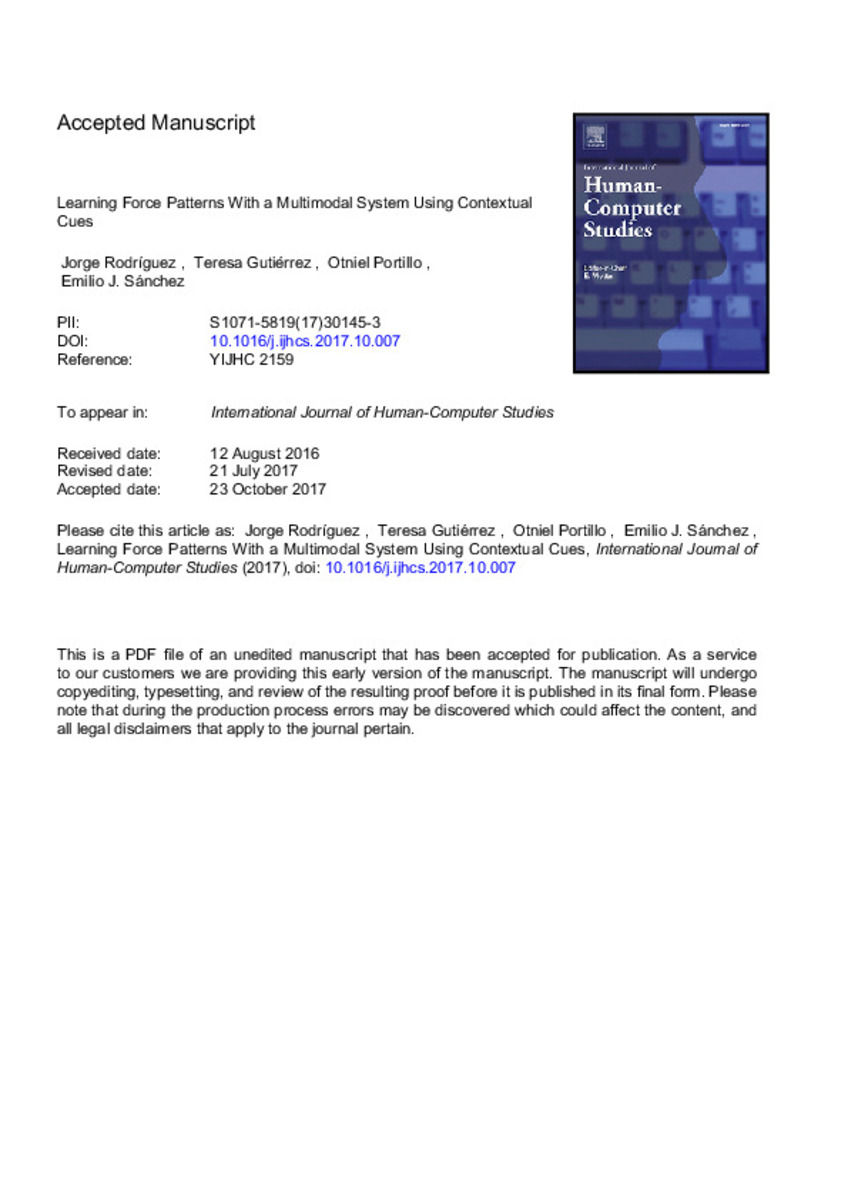Full metadata record
| DC Field | Value | Language |
|---|---|---|
| dc.creator | Rodriguez-Arce, J. (Jorge) | - |
| dc.creator | Gutierrez, T. (Teresa) | - |
| dc.creator | Portillo, O. (Otniel) | - |
| dc.creator | Sanchez-Tapia, E.J. (Emilio José) | - |
| dc.date.accessioned | 2024-02-28T16:29:47Z | - |
| dc.date.available | 2024-02-28T16:29:47Z | - |
| dc.date.issued | 2018 | - |
| dc.identifier.citation | Rodríguez, J., Gutiérrez, T., Portillo, O., & Sánchez, E. J. (2018). Learning force patterns with a multimodal system using contextual cues. International Journal of Human-Computer Studies, 110, 86-94. | es_ES |
| dc.identifier.issn | 1071-5819 | - |
| dc.identifier.uri | https://hdl.handle.net/10171/69189 | - |
| dc.description.abstract | Previous studies on learning force patterns (fine motor skills) have focused on providing "punctual information", which means users only receive information about their performance at the Current time step. This work proposes a new approach based on "contextual information", in which users receive information not only about the current time step, but also about the past (how the target force has changed over time) and the future (how the target force will change). A test was run to compare the performance of the contextual approach in relation to the punctual information, in which each participant had to memorize and then reproduce a pattern of force after training with a multimodal system. The findings suggest that the contextual approach is a useful strategy for force pattern learning. The advantage of the contextual information approach over the punctual information approach is that users receive information about the evolution of their performance (helping to correct the errors), and they also receive information about the next forces to be exerted (providing them with a better understanding of the target force profile). Finally, the contextual approach could be implemented in medical training platforms or surgical robots to extend the capabilities of these systems | es_ES |
| dc.description.sponsorship | This research was supported in part by the European Commission Integrated Project IP-SKILLS-35005. Additionally, the research stay of J. Rodríguez at CEIT was supported by SEP-PRODEP (Mexico) through the “Programa de apoyo a la incorporación de NPTC ”. Finally, the authors would like to thank Wendy Baldwin for commenting and proofreading this work. | es_ES |
| dc.language.iso | eng | es_ES |
| dc.publisher | Elsevier | es_ES |
| dc.rights | info:eu-repo/semantics/openAccess | es_ES |
| dc.subject | Force skill training. | es_ES |
| dc.subject | Motor skill training. | es_ES |
| dc.subject | Virtual training. | es_ES |
| dc.subject | Multimodal training. | es_ES |
| dc.title | Learning force patterns with a multimodal system using contextual cues. | es_ES |
| dc.type | info:eu-repo/semantics/article | es_ES |
| dc.editorial.note | CC BY-NC-ND | es_ES |
| dc.identifier.doi | 10.1016/j.ijhcs.2017.10.007 | - |
Files in This Item:
Statistics and impact
Items in Dadun are protected by copyright, with all rights reserved, unless otherwise indicated.






